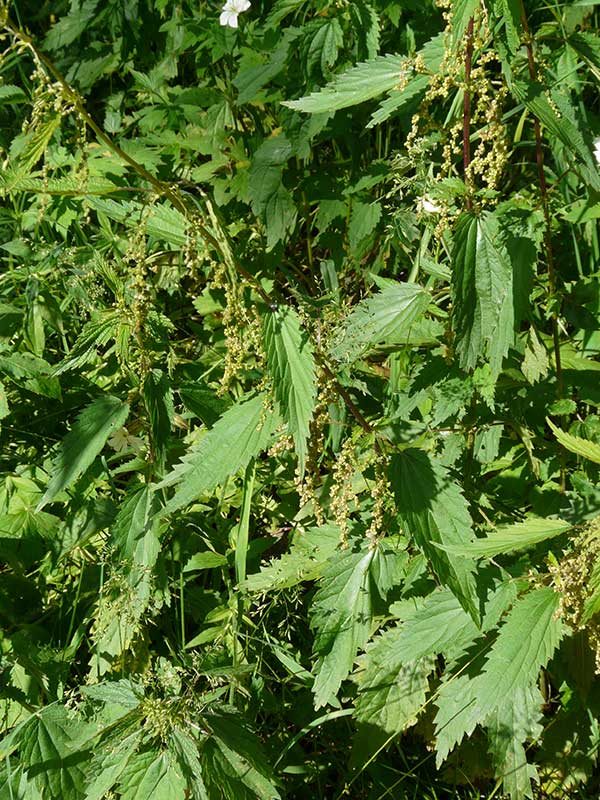Urtica dioica / stinging nettle
- near streams and moist bogs, in woodland understories, disturbed places, wastelands
- leaves – strongly serrated margin, a heart-shaped base, a pointed tip
- flower – greenish or brownish in dense dangling clusters
- nasty hairs that sting you
Synonym: Urtica serra
Stinging nettle is common herbaceous perennial in wet areas throughout the forests of central Idaho. It stands upright (3-6 feet) but the plant is thin, not bushy. It is clonal, by rhizomes, and therefore usually occurs in dense patches. If you touch it, the sensation ranges from “interesting” to one of extreme discomfort. Still, I’d rather run into this by accident than, say, poison oak. The sting is attributable to a combination of histamines and formic acid contained in tiny, hollow, sharp trichomes (hairs) on the stem, leaves and flowers. These basically impale your skin, break off, and inject the offending compounds. Still, young stinging nettle leaves (but NOT flowers!) can be eaten if cooked, or made into tea. Different individual plants can have quite different densities of these trichomes.
Stinging nettle has soft leaves up to 6″ long, long petioles and leaf-like stipules at the point of attachment to the stem. Borne oppositely on a square stem, the leaves have a strongly serrated margin, a heart-shaped base, and a pointed tip. To my mind, they look like mint leaves despite being in a completely different family.
Stinging nettle flowers are quite small and greenish/brownish. They are borne in dense, dangly clusters (panicles) arising from the leaf axils. As with other teeny flowers, they are difficult to photograph or even recognize by themselves but the inflorescences are quite distinctive. The flowers do actually have 4 tepals in different-sized pairs. Male and female may either be on different plants or separated spatially with males higher on the stem than females. The flowers are wind pollinated.
Nettles grow near streams and moist bogs, in woodland understories and disturbed places/wastelands. They are fine with either sun or shade, and flourish with rich soil, and can be used as indicators of high nutrients. In that line, they are often associated with abandoned human habitations where levels of nitrogen and phosphorous are high (think – outhouses). Interestingly, they are also tolerant of heavy metals in the soil.
Nettle root systems are characterized by large and fast growing rhizomes leading to formation of dense stands. Like other plants with this characteristic, cultivation is actually a good way to spread them unless it is combined with cutting and repeated often over a period of several years. Nettles also reproduce by seed. Seed production is copious and seeds remain on the plant until after frost. Once dispersed, they can germinate immediately but can also persist in the seed bank for a decade or more.
I find it interesting that, when looking for information one stinging nettles, there are two major types of results. First, there is considerable information available on its control and eradication. Second, in contrast, is an emphasis on just how useful and beneficial this plant can be. For example, its fibre can be used the same way as flax, and has been used since the Stone Age to make nets, and later, clothes. Or… it is reported to have a vast array of traditional uses in herbal medicine. It is quite nutritious and has been used as animal fodder (although the stinging bit is a liability) and as people food. Boiled nettles are a “spinach substitute” (as are, apparently any leaves that can be boiled and eaten).
Of course, the most magical use for stinging nettles was highlighted in Hans Christian Anderson’s telling of “The Wild Swans” in which 11 brothers are turned into swans by a wicked queen/stepmother and can be freed only if their sister collects nettles, weaves them into cloth and makes coats for the boys, all silently. Spoiler alert… she does.
But Eliza wasn’t the only one to make this magic! You can too! For a mere $3, you can get an ounce of dried leaves which are billed as…
“A powerful magical herb offering protection against poisonous thoughts and intentions… used to remove curses and help in exorcisms. Place along door sills, windows and the corners of rooms (keep out of reach of children and pets). Comes in a resealable bag.” [not effective against grizzly bears].
| Color | |
|---|---|
| Family | |
| Blossom size | |
| Inflorescence size | |
| Inflorescence type | |
| When? | |
| Where? |


